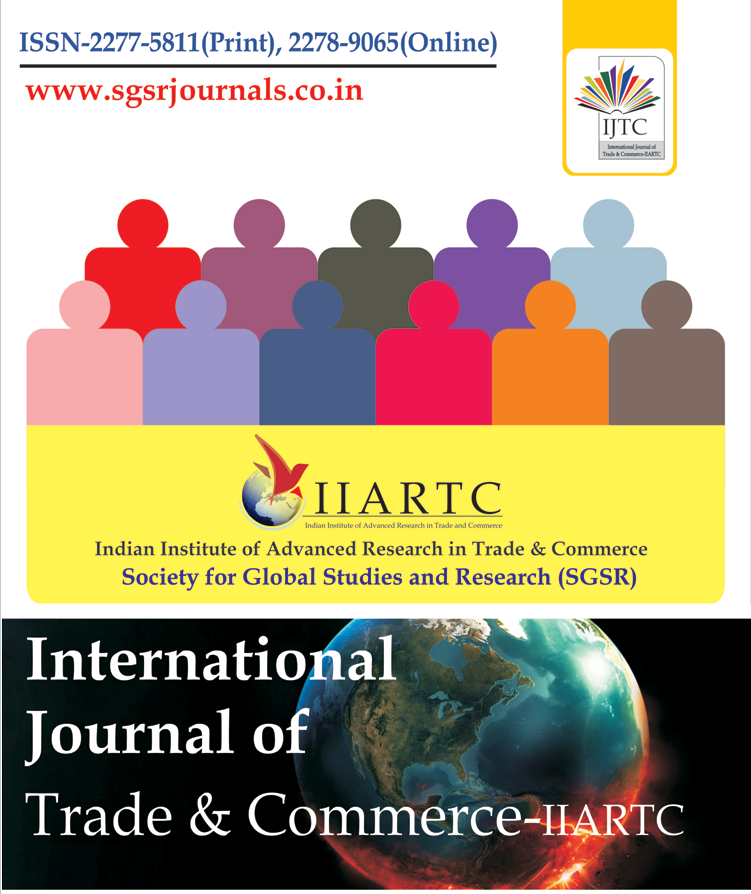Home ⇨ International Journal of Trade & Commerce-IIARTC

International Journal of Trade & Commerce-IIARTC
Impact Factor (IF):5.135 (COSMOS), IF:7.249 (ISRA), IF:3.721 (ISI)
ISSN:2277-5811 (P), ISSN:2278-9065 (O)
Frequency: Half Yearly
Inflow of FDI in Banking Sector
Foreign direct investment is the investment made by a foreign individual or company in productive capacity of another country. It is the movement of capital across national frontiers in a manner that grants the investor to control over the acquired asset. Inflow of Foreign investment is the main economic activity for the development of country. There are two basic types of foreign investment. 1.) Foreign direct investment 2.) Foreign portfolio investment. This abstract is based on the foreign direct investment in banking industry in India. Banking sector is the main sector of a country. Because over all development of the country is fully dependent on the growth of banking sector. Banking sector creates the infrastructure development as well as economical development. The performance of foreign banks in India and compare the foreign bank to the Indian domestic banks whether public banks or private banks. There are various angles in which analyze the performance of foreign banks like according to the investment, growth, market share, profitability etc. On the basis of all these angles researcher is analyzing the performance of foreign banks in India. The banking industry in India seems to be unaffected from the global financial crises which started from U.S in the last quarter of 2008. Despite the fallout and nationalization of banks across developed economies, banks in India seems to be on the strong fundamental base and seems to be well insulated from the financial turbulence emerging from the western economies. The Indian banking industry is well placed as compare to their banking industries western counterparts which are depending upon government bailout and stimulus packages. The strong economic growth in the past, low defaulter ratio, absence of complex financial products, regular intervention by central bank, proactive adjustment of monetary policy and so called close banking culture have favored the banking industry in India in recent global financial turmoilance. The RBI, which is the regulator of the banking sector, had a strong case for issuing elaborate guidelines on bank ownership to ensure diversification. Those reasons retain their relevance even today. So there is no case for altering them, especially if the evidence suggests that accessing foreign equity, if needed, to enhance the capital of banks is possible within the current regulatory framework.
Author:Deepika Madana, Renu Tyagib
Abstract:Foreign direct investment is the investment made by a foreign individual or company in productive capacity of another country. It is the movement of capital across national frontiers in a manner that grants the investor to control over the acquired asset. Inflow of Foreign investment is the main economic activity for the development of country. There are two basic types of foreign investment. 1.) Foreign direct investment 2.) Foreign portfolio investment. This abstract is based on the foreign direct investment in banking industry in India. Banking sector is the main sector of a country. Because over all development of the country is fully dependent on the growth of banking sector. Banking sector creates the infrastructure development as well as economical development. The performance of foreign banks in India and compare the foreign bank to the Indian domestic banks whether public banks or private banks. There are various angles in which analyze the performance of foreign banks like according to the investment, growth, market share, profitability etc. On the basis of all these angles researcher is analyzing the performance of foreign banks in India. The banking industry in India seems to be unaffected from the global financial crises which started from U.S in the last quarter of 2008. Despite the fallout and nationalization of banks across developed economies, banks in India seems to be on the strong fundamental base and seems to be well insulated from the financial turbulence emerging from the western economies. The Indian banking industry is well placed as compare to their banking industries western counterparts which are depending upon government bailout and stimulus packages. The strong economic growth in the past, low defaulter ratio, absence of complex financial products, regular intervention by central bank, proactive adjustment of monetary policy and so called close banking culture have favored the banking industry in India in recent global financial turmoilance. The RBI, which is the regulator of the banking sector, had a strong case for issuing elaborate guidelines on bank ownership to ensure diversification. Those reasons retain their relevance even today. So there is no case for altering them, especially if the evidence suggests that accessing foreign equity, if needed, to enhance the capital of banks is possible within the current regulatory framework.




